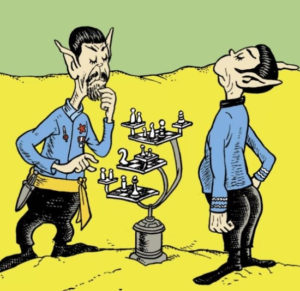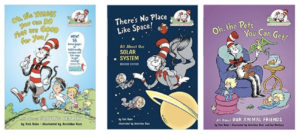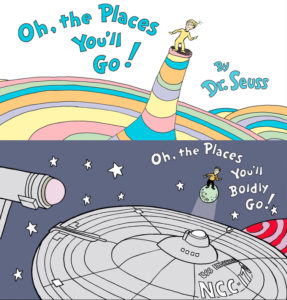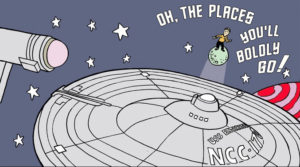 Yesterday in part 1, we discussed the copyright side of the infringement lawsuit that was filed by Dr. Seuss Enterprises (DSE) against Star Trek “Tribbles” creator DAVID GERROLD and comic book artist TY TEMPLETON for their proposed “mash-up” book Oh, The Places You’ll Boldly Go! The project generated $30,000 in a Kickstarter that was promptly shut down (and the donations frozen) when DSE asserted their ownership of the Dr. Seuss property. A lawsuit quickly followed in late 2016 accusing the mash-up creators and their publisher ComicMix of both copyright AND trademark infringement (two different things, as I’ll explain shortly).
Yesterday in part 1, we discussed the copyright side of the infringement lawsuit that was filed by Dr. Seuss Enterprises (DSE) against Star Trek “Tribbles” creator DAVID GERROLD and comic book artist TY TEMPLETON for their proposed “mash-up” book Oh, The Places You’ll Boldly Go! The project generated $30,000 in a Kickstarter that was promptly shut down (and the donations frozen) when DSE asserted their ownership of the Dr. Seuss property. A lawsuit quickly followed in late 2016 accusing the mash-up creators and their publisher ComicMix of both copyright AND trademark infringement (two different things, as I’ll explain shortly).
It’s now a year later, and a whole flurry of legal posturing has been going on back and forth…before the trial even gets started! During the summer, Judge JANIS L. SAMMARTINO of the Ninth Circuit Federal Court in San Diego dismissed the trademark complaint portion of the lawsuit, leaving only the copyright claim to adjudicate. And even there, it looked like the judge was leaning strongly in favor of accepting a fair use defense from “Team Mash-up” (as I like to call them) and dismissing the rest of the case, as well.
But DSE was not about to go gently into that good night! And after pulling out all the legal stops, and after a court hearing at the end of last month, Judge Sammartino just issued an Order Denying Motion to Dismiss that not only allowed the copyright portion of the lawsuit to continue and go to trial, but DSE lawyers also convinced her to CHANGE HER MIND and reinstate the trademark complaint!
How the heck did that happen???
Yesterday, I explained the reasons that the judge didn’t grant a fair use defense on the question of copyright infringement. Today, we’ll take a look at the trademark side of things and discover why we can blame Godzilla for the judge’s decision to resurrect the trademark question…
There’s a common misconception that copyrights and trademarks are interchangeable terms. They’re not. Copyright deals with the creative content of a work of art—the text of a book or play, the melodies of music, the characters or storylines of movies, TV shows, and literary works, etc.
Trademarks are much more specific. You trademark a distinctive word or name (like Geico or Sony), a phrase (“The Happiest Place on Earth”), a logo (the McDonald’s golden arches “M”), a jingle (like the four-note “Intel inside” riff that comes at the end of their commercials), or a specific image (the refit U.S.S. Enterprise from the first six Trek movies was once trademarked). The University of Kentucky was once able to trademark the word “Kentucky,” but only when it appeared on a T-shirt or sweatshirt. You can even trademark a color! (Yep, you actually can’t use “Barbie pink” or “Tiffany blue” in a commercial design.)
And while copyrights don’t need to be vigorously defended with cease and desist letters or lawsuits in order to be retained by their owners, trademarks do require that kind of proactive enforcement…or else risk losing the owner’s ability to pursue that protection later.
In the case of DSE, when they filed a motion to reinstate their trademark complaint against the mash-up, they were asserting infringement over three things in particular:
- The title Oh, The Places You’ll Go!
- The distinctive look and feel of the fonts used on all of their books,
- The artistic drawing style of Dr. Seuss.
In the end, the judge gave them two out of three. Trademarking the title was valid because of many versions of it that adorned licensed derivative books like these…
While the judge didn’t feel it was necessary to examine or rule on ALL of the various fonts used in ALL of the Dr. Seuss books (from Horton Hears a Who to The Lorax to Green Eggs and Ham and dozens and dozens of others), she did agree that the font used for the words on the cover to Oh, The Places You’ll Go! was deserving of consideration as a valid trademark, as well.
As for drawing style, well, that’s a toughie. You can trademark a specific drawing or a specific character, like Bugs Bunny or Mickey Mouse (or The Cat in the Hat!), but not a whole artistic style. So the judge said “no” on that one. But two out of three ain’t bad.
Team Mash-up was trying to argue something known as “nominative fair use” (which is different than “fair use” for copyrights). Here’s an example of how nominative fair use works. Let’s say you’re a mechanic and you specialize in servicing Porsches. So you display the Porsche name on your large sign above your shop: “JOE’S PORSCHE REPAIR.” That’s actually okay. You need to use the trademarked name to explain who you are and what you do. You’re not competing or creating confusion in the marketplace, as you’re not selling Porsches…only fixing them. As long as you don’t use more than you need to communicate what you do (for example, you need to use the name but not necessarily the Porsche logo), you’re good with not paying a license fee to Porsche. You just have to be careful not to imply that Porsche is directly sponsoring or endorsing you.
Team Mash-up argued that they essentially did the same. They needed to use the title Oh, The Places You’ll Go! in order to explain what they were: a mash-up of Dr. Seuss and Star Trek. And the reason they didn’t use the exact same title was because they needed to add the word “Boldly” to explain the Star Trek tie-in. And in fact, the judge agreed with the defendants. As far as she was concerned, that was absolutely nominative fair use. The judge also agreed that the defendants had done nothing to imply that they had the endorsement of DSE, which is a second test of nominative fair use.
So why has trademark infringement been reinstated in the lawsuit? You’re probably not gonna believe this, but it was all Godzilla‘s fault!
Back in 1998, William Morrow & Co. was advertising and publishing a 227-page Godzilla compendium book entitled Godzilla! A Japanese corporation named Toho, which created Godzilla in 1954 and owned a trademark on the name and character, sued Morrow for infringement. Morrow attempted to use the nominative fair use defense in saying that they needed to use the name and image of Godzilla in order to explain to people what they were selling.
There was only one problem, and it resulted in a court injunction against the book. Morrow had used the exact same font to write the word GODZILLA! in large, friendly blocky letters on the book’s cover. The court felt that Morrow could have simply written the title without using the same font and image of Godzilla. They “could adequately communicate their message without using the visual trappings of [the Plaintiff’s] brand.”
Team Mash-up inadvertently stepped into the same pile of poo. Citing the Godzilla case, the judge agreed with DSE that the use of the exact same font as their own book’s title was a bridge too far…
The mash-up uses the same font, the same curvature of the words, even the same angle on the exclamation point. That was enough to resurrect the trademark complaint and add it back into the lawsuit:
The Court finds it was unnecessary for Defendants to use the distinctive font as used on Go! to communicate their message (i.e., that Boldly is a mash-up of the Go! and Star Trek universes). The Court concludes Defendants have not satisfied this nominative fair use factor.
[B]ecause Defendants are not able to satisfy each factor of the nominative use defense, the Court finds Defendants’ use of the mark is not shielded by the defense. Accordingly, the Court denies Defendant’s Motion to Dismiss as to this regard.
Now, is this a brown-trousers moment for Team Mash-up? Well, not necessarily. In my opinion at least, the trademark complaint was resurrected on a technicality…and can probably be solved pretty easily. Just change the typeface! It’s not too late. No product was ever created nor sold, and the donations made to Kickstarter were never disseminated to the authors or ComicMix.
In short, there was no trademark infringement in terms of actual trade or commerce. No money was made or lost. So if the authors and ComicMix announce during the trial that they intend to go with a new title that looks something like this…
…then they should be able to easily flip the switch back on for successfully using the nominative fair use argument. (Then again, I’m not the lawyer in the family, just the graphic designer and blog writer.)
As for the copyright side of the equation, well, that’s a stickier wicket, to be sure…and it really could go either way. Unlike the trademark nominative fair use—which has a “one strike and you’re out” philosophy—that is not the case for copyright fair use. You don’t need to prove all four factors in your favor in order to convince a jury that you’re not infringing. It’s more of a holistic, overall impression…which is kinda why many judges don’t like handing over the determination of fair use to a jury. (In the last 30 years, many judges, like the one in the Axanar case, have issued summary judgements on fair use as a matter of law, rather than let a jury decide the question as a matter of fact. That doesn’t seem to be the case here, however.)
So it’s possible that a jury might decide that, yes, Oh, The Places You’ll Boldly Go! is, in fact, transformative enough to be considered fair use, despite the potential loss of licensing revenue from mash-up deals. On the other hand, a jury could say that they don’t care how transformative the mash-up is, it’s DSE’s right to license it any way they see fit. And depriving the company of any potential licensing opportunities, even opportunities that DSE might never pursue, is just not appropriate.
And so, despite the defense having enjoyed a huge lead halfway through the game, the score is now tied as we head into overtime…and it’s anybody’s game!



I dunno what DG and the gang thought was gonna happen when mashing up TWO heavily litigious franchises, and trying to claim ‘parody’ when parody has to be a satirical ‘comment’ on the original work in this some way, and this was CLEARLY not that, but a means of creating instant visibility, presumably for added commercial gain that original properties can’t attract right out the barn door.
If we don’t expect large entities to slap down blatant cash grabs of creative content they own, that sends a message that smaller content creators don’t have the right to defend ownership of their creation and I do NOT support that as a Creative Professional, PERIOD.
I don’t entirely disagree with you, Gabe. You make some excellent points. But I feel this is a discussion that needs to happen…both inside and outside the courtroom. As Judge Sammartino herself noted, the concept of a “mash-up” is a new and potentially significant genre of art…and the whole purpose of the first amendment is protect free speech (which includes art). On the other hand, copyrights and trademarks are also intended to encourage creation by insuring that such endeavors can result not just in self satisfaction but also profit and control of the intellectual property.
So how do we balance copyright protections and the first amendment? Was Andy Warhol ripping off Campbell’s Soup when he turned their label into multi-million dollar museum pieces or mass-produced art prints? If someone mashes up “The Flintstones” and AMC’s latest mega-hit and calls it “The Walking Fred,” is that infringement or just creativity? Does the work need to be satirical commentary…and what exactly is satirical comedy? Maybe “Oh, the Places You’ll Boldly Go!” is satirical comedy. Yes, I know that this judge ruled that it wasn’t parody, but she did grant it the legal description of transformative. Is that enough to qualify as fair use?
As I said in the blog entry, we’re going to find out. And it could go either way. And in the end, somebody ain’t gonna like or agree with the verdict. But mash-ups aren’t going away anytime soon. So if it isn’t a Dr. Seuss/Star Trek mash-up triggering the discussion and debate, it’s sure to be something else soon enough!
I think another interesting element to add is the fact that during the 90’s, many musical acts were able to thrive with ‘samples’, making songs out of sequenced snippets of older songs, often several of them, and layering them.
This is where I think we could use more “creative lawyers”, capable of seeing Clear Context.
For example, to me, Andy Warhol was NOT trying to “sell his own knockoff of campbells soup”, he wasn’t in the soup business. That iconography was a socio political metaphor.
However, your “Walking Fred” premise immediately reads to me as egregious violations of creative ethics.
I am in agreement with you that this is a conversation that ‘needs to happen’, and that because people only learn the Hard Way, ‘needs to happen’ in a playing field that has Actual Consequences.
So to court it is…
Well, once again, the rights owners failed to see a business opportunity. They could just ransom the mash-up authors and ask for easy money in exchange of permission to proceed. Of course, it would require authorization for all works used.
Mash-up is new, so is the revenue it could bring for owners which can control who makes what with their property and earn money for them just watchin it be done.
I, for one, would seriously consider getting money so easy. And there wouldn’t have been the Axanar lawsuit if CBS considered it too.
Amateur (and pro) photographers sell rights on their works to companies that use it for business purposes. If they don’t do so, the companies will buy elsewhere and still have what they want, so they sell and get the money instead of letting it going to competition. Those who don’t sell often cry when they find a similar work from someone else has been used and sue the client they did not accept to work with…
In this case, DSE could have not only earned money but get free exposition, negociating the insertion of an advertisement page in the mash-up publication. You see, there are many possibilities for open-minded businessmen, but all those pitbulls are too busy biting to see it…
Regards,
Nicolas.
The problem is that a small publisher with only $30K can’t afford a license…especially paid to two different rights holders. And licensing fees aren’t simply handing over your profit to line the coffers of the “fat cats.” There are folks in the licensing departments of these companies who get paid salaries, there is rent on their office space, computers on their desks, etc. Licensing revenue is put toward these expenses. And lest you think that it amortizes and eventually you’ve paid for everything with just a few licenses and the rest is gravy, that’s not the case. Each licensing supervisor can only handle so many licensees at one time. If more licensees are added, eventually you have to hire more licensing employees. It can be a very demanding job. Trust me, I watched it being done for eight years.
My guess in all this is a fine point of: if no money is exchanged, and it did not result in personal game, no harm, no foul. The whole litigious nature of today is so bad, that even a 1st amendment justification can be subject to ruinous legal wrangling. The whole system has decayed to where the only one who wins is the lawyers. Look at class actions, I have gotten probably 20 or 30 “notices” in the last 20 years, and all of them end up like a cracker jack toy “after legal fees, the 20 million dollar settlement will result in each member of the class getting 2.52 in compensation”. Yet the lawyers walked out with 3 or 4 million. Eventually, no one will want to make fan films, fan art, fan anything, for fear of getting involved in a ruinous lawsuit (like a certain fan funded Star Trek movie).
99% of fan films aren’t getting sued. Look, I don’t blame DSE for suing ComicMix. In terms of trademark, it’s almost mandatory. And letting things slide on the copyright side would just invite even more attempts at infringement. And in fact, some of those attempts bear fruit. Look at that Cindy-Lou Who play that was a sequel to “How the Grinch Stole Christmas.” DSE sued for copyright infringement and lost. They might lose here, too, but they might win. They at least have to try.